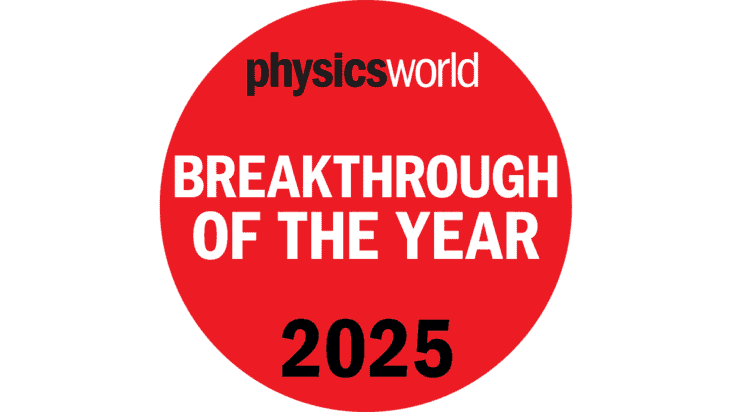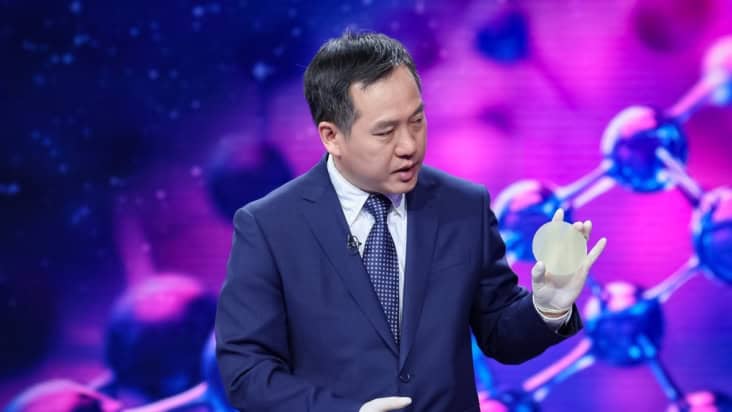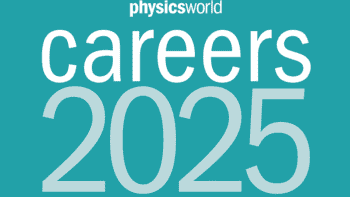

This podcast features a winner of the Physics World 2025 Breakthrough of the Year

Tiny pores block heat while transmitting light
New characterization of the material's surface reveals how an atom-level rearrangement aids the formation of ice crystals and promotes precipitation
 Read article: Scientists explain why ‘seeding’ clouds with silver iodide is so efficient
Read article: Scientists explain why ‘seeding’ clouds with silver iodide is so efficient
Technique reveals how organic materials accumulate charge
 Read article: Slow spectroscopy sheds light on photodegradation
Read article: Slow spectroscopy sheds light on photodegradation
Multipurpose structures could find use in targeted drug delivery, catalysis, microelectronics and tissue engineering
 Read article: ‘Patchy’ nanoparticles emerge from new atomic stencilling technique
Read article: ‘Patchy’ nanoparticles emerge from new atomic stencilling technique
Topological kagome tubes isolate vibrations to one end, keeping the other end safe
 Read article: New cylindrical metamaterials could act as shock absorbers for sensitive equipment
Read article: New cylindrical metamaterials could act as shock absorbers for sensitive equipment
New technique could deliver reconfigurable phononic devices with myriad applications
 Read article: Twistelastics controls how mechanical waves move in metamaterials
Read article: Twistelastics controls how mechanical waves move in metamaterials
Nearly all light emitted by nitrogen-vacancy centres can be collected, providing a boost for these room-temperature quantum technology platforms
 Read article: Chip-integrated nanoantenna efficiently harvests light from diamond defects
Read article: Chip-integrated nanoantenna efficiently harvests light from diamond defects
The 2025 edition of Physics World Careers is packed full of advice for early-career scientists. Including a range of valuable advice, informative case studies and recruiter profiles, it demonstrates the variety of jobs that use a physics degree.

Noda made breakthroughs in the development of the Photonic Crystal Surface Emitting Laser
 Read article: Semiconductor laser pioneer Susumu Noda wins 2026 Rank Prize for Optoelectronics
Read article: Semiconductor laser pioneer Susumu Noda wins 2026 Rank Prize for Optoelectronics
We report from the Heidelberg Laureate Forum
 Read article: Designing better semiconductor chips: NP hard problems and forever chemicals
Read article: Designing better semiconductor chips: NP hard problems and forever chemicals
This podcast features Antonio Rossi at the Italian Institute of Technology
 Read article: Unlocking the potential of 2D materials: graphene and much more
Read article: Unlocking the potential of 2D materials: graphene and much more
Waveguide-style approach promises to pair the versatility of phononic quantum technologies with the tight control of photonic ones
 Read article: Single-phonon coupler brings different quantum technologies together
Read article: Single-phonon coupler brings different quantum technologies together
Device is flexible and transparent to visible light
 Read article: Wearable UVA sensor warns about overexposure to sunlight
Read article: Wearable UVA sensor warns about overexposure to sunlight
Trio honoured for their work on metal-organic frameworks
 Read article: Susumu Kitagawa, Richard Robson and Omar Yaghi win the 2025 Nobel Prize for Chemistry
Read article: Susumu Kitagawa, Richard Robson and Omar Yaghi win the 2025 Nobel Prize for Chemistry
Honor Powrie pays tribute to the work of materials scientists
 Read article: Is materials science the new alchemy for the 21st century?
Read article: Is materials science the new alchemy for the 21st century?
New system does not need to drift to avoid turbulence
 Read article: Kirigami-inspired parachute falls on target
Read article: Kirigami-inspired parachute falls on target
Stefan Hutzler and Louise Bradley explain how they turned the famous pitch-drop experiment into an outreach activity
 Read article: How the slowest experiment in the world became a fast success
Read article: How the slowest experiment in the world became a fast success
New measurements on Bose–Einstein condensate could help us better understand how objects transition from being quantum and ordered to classical and chaotic
 Read article: Quantum gas keeps its cool
Read article: Quantum gas keeps its cool
New finding advances our understanding of complex topological quantum systems and could help in the development of next-generation memory and storage devices
 Read article: Quantum fluid instability produces eccentric skyrmions
Read article: Quantum fluid instability produces eccentric skyrmions
New topotactic oxide material could be used in some clean energy technologies including fuel cells
 Read article: ‘Breathing’ crystal reversibly releases oxygen
Read article: ‘Breathing’ crystal reversibly releases oxygen
Device can process signals at frequencies ranging from below 1 GHz to more than 100 GHz
 Read article: Broadband wireless gets even broader thanks to integrated transmitter
Read article: Broadband wireless gets even broader thanks to integrated transmitter
Researchers combine machine learning with data mining methods to create a record-breaking underwater adhesive hydrogel
 Read article: Super sticky underwater hydrogels designed using data mining and AI
Read article: Super sticky underwater hydrogels designed using data mining and AI
Images are the first experimental evidence of long-predicted low-energy atomic vibrations called moiré phasons in twisted 2D materials
 Read article: Highest-resolution images ever taken of a single atom reveal new kind of vibrations
Read article: Highest-resolution images ever taken of a single atom reveal new kind of vibrations
Benchtop accelerator links electrochemistry to fusion science
 Read article: Electrochemical loading boosts deuterium fusion in a palladium target
Read article: Electrochemical loading boosts deuterium fusion in a palladium target
Devices are levitated by sunlight alone
 Read article: Nano-engineered flyers could soon explore Earth’s mesosphere
Read article: Nano-engineered flyers could soon explore Earth’s mesosphere
A new hybrid copper iodide semiconductor converts nearly all the photoenergy it receives into blue light
 Read article: Deep-blue LEDs get a super-bright, non-toxic boost
Read article: Deep-blue LEDs get a super-bright, non-toxic boost